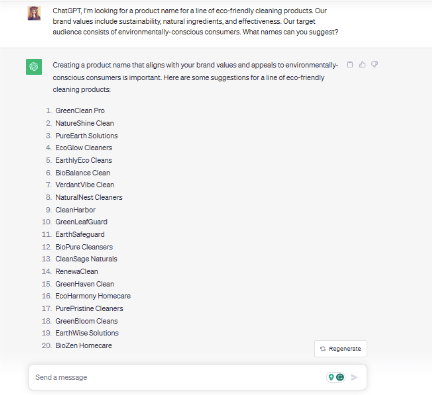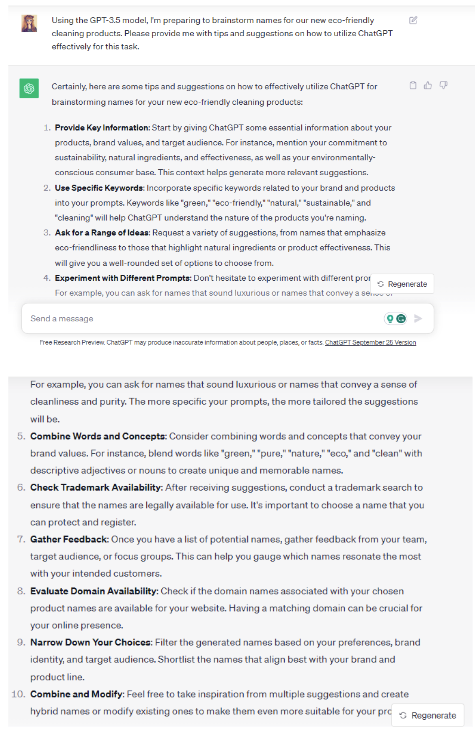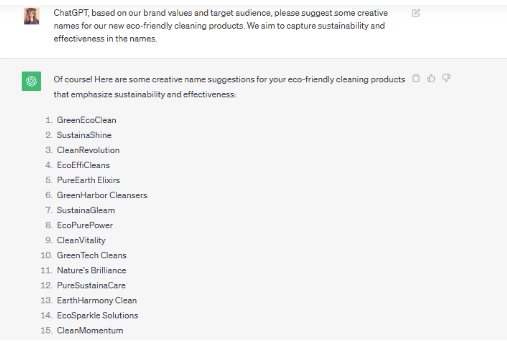
In the vast landscape of business and marketing, a product’s name is more than just a collection of letters; it’s a cornerstone of your brand’s identity.
A well-crafted product name encapsulates the essence of what you offer and has the power to resonate with your target audience. It can make or break your marketing efforts and leave a lasting impression.
Today, in the age of artificial intelligence, the process of generating these all-important product names has been revolutionized.
Enter ChatGPT, a powerful AI tool that can assist you in conjuring creative and relevant product name ideas.
In this blog, we will explore how ChatGPT can be harnessed to streamline this creative process and offer a wealth of naming possibilities.
Let’s dive into the essential steps involved in creating product name ideas using ChatGPT.
The Role of a Product Name
A product name serves as your brand’s ambassador.
It’s the first thing that potential customers encounter, and it should convey your brand’s values, promise, and unique selling points. For instance, consider the name “Apple” for a technology company.
It’s simple, memorable, and reflects innovation and a focus on user-friendliness.
Real-world examples:
- Coca-Cola: This iconic name suggests effervescence and enjoyment, aligning perfectly with the brand’s image.
- Tesla: Named after the brilliant inventor Nikola Tesla, this name evokes innovation and forward-thinking.
The Process of Generating Product Name Ideas with ChatGPT
Step 1: Defining Your Brand and Product
Before ChatGPT can work its magic, you need to provide it with a clear understanding of your brand and product.
Let’s take the example of a new line of eco-friendly cleaning products.
Prompt example: ChatGPT, I’m looking for a product name for a line of eco-friendly cleaning products. Our brand values include sustainability, natural ingredients, and effectiveness. Our target audience consists of environmentally-conscious consumers. What names can you suggest?

Step 2: Preparing ChatGPT
Not all AI models are the same, and not all settings are suitable for every task. Choosing the right model and configuring the settings can significantly impact the quality of name suggestions.
Prompt example: Using the GPT-3.5 model, I’m preparing to brainstorm names for our new eco-friendly cleaning products. Please provide me with tips and suggestions on how to utilize ChatGPT effectively for this task.

Step 3: Generating Initial Product Name Ideas
This is where ChatGPT’s creative capabilities shine. It can generate a range of names based on the information you provide.
Prompt example: ChatGPT, based on our brand values and target audience, please suggest some creative names for our new eco-friendly cleaning products. We aim to capture sustainability and effectiveness in the names.

Step 4: Refining the Ideas
The generated names are just a starting point. It’s essential to refine them and select the most promising ones. Gathering feedback from colleagues or conducting focus groups can be invaluable in this stage.
Step 5: Trademark and Domain Availability
After narrowing down your options, it’s crucial to ensure the chosen names are legally and practically feasible. Trademark and domain availability are vital considerations.
When considering domain availability, exploring .ai domains could be a strategic choice, especially for technology and AI-related products, ensuring a relevant and modern online presence.
Creative Tips for Using ChatGPT
1. Leveraging ChatGPT's Creativity
Encourage ChatGPT to explore creative and unconventional name ideas. Ask it to think outside the box and suggest names that stand out in the market.
Let ChatGPT surprise you with imaginative and unique name suggestions that align with your brand.
2. Combining Words, Concepts, and Languages
Leverage ChatGPT’s multilingual capabilities to combine words and concepts from different languages.
Create names that are intriguing and memorable by fusing elements from diverse linguistic backgrounds.
Experiment with linguistic fusion to make your product names more distinctive and appealing.
3. Avoiding Common Naming Pitfalls
Request ChatGPT to help you avoid commonly used words or phrases that may lack uniqueness.
Use AI to identify potential trademark issues and ensure that the generated names are distinct. Check for existing products in your industry to avoid similarities and potential legal challenges.
Ethical Considerations
1. Originality and Trademarks
It’s essential to ensure that the names generated by AI are original and do not infringe on existing trademarks.
Copying or closely mimicking the names of established products or brands can lead to legal disputes and damage your brand’s reputation.
Before finalizing a product name, conduct thorough trademark searches to ensure that it’s not already registered or in use by another company. This step helps you avoid potential trademark infringement issues that could result in costly legal battles.
2. Cultural Sensitivity
Be cautious about generating names that could be considered culturally insensitive or appropriative.
Using elements from a culture without understanding their significance or without permission can lead to backlash and harm your brand’s reputation.
Strive for inclusivity in your product names. Avoid names that may offend or exclude certain cultural groups.
Sensitivity to cultural diversity is not only ethical but also essential for building a positive brand image.
3. Transparency and Disclosure
In cases where AI plays a significant role in generating product names, it’s important to be transparent with your customers.
Disclose the use of AI in the naming process to maintain trust and transparency in your marketing.
While AI can assist in name generation, human oversight is crucial. Ensure that the final selection of a product name is made with human judgment, taking into account cultural, ethical, and legal factors.
Conclusion
Leveraging ChatGPT for generating product name ideas offers a powerful and creative solution.
By considering ethical guidelines, originality, and cultural sensitivities, businesses can ensure that their product names leave a positive and lasting impact on their customers and their brands.
Discover More AI Tools
Every week, we introduce new AI tools and discuss news about artificial intelligence.
To discover new AI tools and stay up to date with newest tools available, click the button.
To subscribe to the newsletter and receive updates on AI, as well as a full list of 200+ AI tools, click here.







